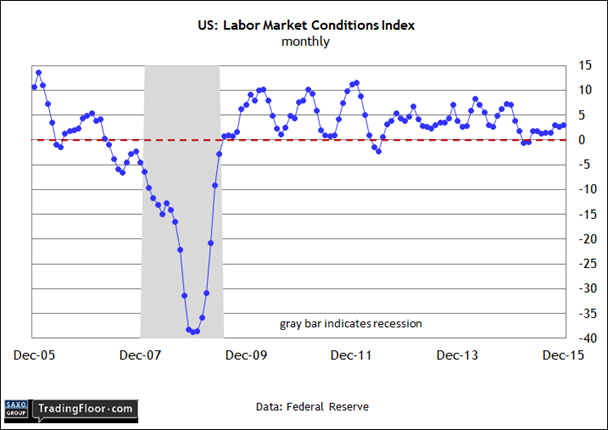On a slow day for economic news, today’s update on eurozone investor sentiment via Sentix will help set the tone for macro expectations this week. Later, the Federal Reserve updates its Labor Market Conditions Index for January. Meanwhile, keep your eye on the 10-year Treasury yield today in the wake of last week’s sharp deceleration in the pace of US job creation in January.
Eurozone: Sentix Investor Confidence Index (0930 GMT) Europe’s macro trend has made moderate progress in recent months, but the latest batch of data suggests that the momentum has slowed again. That message will probably be reaffirmed in today’s monthly update on investor sentiment across the countries that share the euro.
Meantime, Now-casting.com on Friday downgraded expectations for first-quarter GDP growth in the eurozone to 0.37% (quarter on quarter). That’s still slightly faster than the reported 0.3% rise in Q3.
Investor sentiment souring? Possibly, as today's numbers may confirm.
Meantime, the Q1 nowcast continues to match the projected advance for Q4 GDP, which is scheduled for its initial release on Friday. But in a sign that could be troublesome, Now-casting.com’s Q1 estimates have fallen for three weeks in a row.
There's also signs of a slowdown in the January update of the Eurozone Composite Purchasing Managers' Index (PMI). Although the headline reading still reflects growth, the index dipped to a four-month low last month.
Investors have been downgrading expectations as well. Germany’s DAX, for instance, is off around 14% so far this year and France’s CAC 40 is lower by roughly 9% year-to-date at Friday’s close.
Sentix today will likely report a downgrade today for the general measure of investor sentiment in Europe for this month. If there’s a surprise bound up with today’s report, it will probably lean towards the darker side.
In other words, Europe is again struggling with diminished expectations. The mystery at this point: Is the stumble another temporary soft patch or an early warning of deeper troubles?

US: Labor Market Conditions Index (1500 GMT) Friday’s update on nonfarm payrolls in January delivered news of moderate growth against the previous month, but the headline gain of 151,000 was well below expectations.
Is that a sign that the macro trend is set to weaken in the first quarter and beyond? Today’s numbers for the Federal Reserve's broad measure of labour conditions will help put the trend into clearer context.
Recent updates of the multi-factor Labor Market Conditions Index (LMCI) reflect a modestly firmer trend in recent months. But the readings in the 1-to-3 range since last May, following a brief dip below zero, still look soft compared with the trend in 2014 and early 2015. A fall towards zero in today’s January update will send a message that labour market growth remains shaky at the start to 2016.
The good news is that wage growth strengthened in January, according to last week’s update on payrolls. By some accounts, that’s enough to convince the Fed to continue tightening monetary policy in the months ahead.
“We are likely to have two rate hikes this year, probably in June and December,” Diane Swonk, an independent economist in Chicago, told The New York Times. “But the wage gains are important, so March can’t be ruled out.”
If that’s a viable forecast-particularly for expecting a March hike - we’ll see confirming support in today’s LMCI data. By contrast, a reading that pushes this benchmark close to zero - or below - will give the doves new ammunition for arguing that any rates hikes should be delayed until stronger data arrives in payrolls.

U.S. 10-Year Yield The labour market’s still expanding, as per the January data on payrolls, but the Treasury market isn’t impressed with the numbers. The benchmark 10-year yield in particular slipped again on Friday to 1.86%, according to Treasury.gov - the lowest rate since last April.
Meanwhile, the 2-year yield - considered the most sensitive for rate expectations - ticked higher at last week’s close. Nonetheless, the general consensus is that the economy’s too weak for the Fed to hike rates again at next month’s policy meeting. Fed funds futures are currently pricing in a probability of more than 90% for no change in the March 16 Federal Open Market Committee statement.
Nonetheless, the firmer data on wage growth in Friday’s employment report suggests that the path for monetary policy beyond March is still open for debate.
The January payrolls report “won’t change the current market thoughts on a March increase - we still won’t see any action on rates by the [Fed] in March,” according to the president of EverBank World Markets. “But the average hourly earnings increase should give the hawks something to point to as they argue for four rate increases in 2016.”
But with the US stockmarket sliding into what some analysts now characterise as a bear market - driven by worries about the economy - it’s hard to see how the central bank can rationalise higher rates any time soon.
Doubts or not, some Fed officials still think that it’s game-on for tightening. Loretta Mester, president of the Federal Reserve Bank of Cleveland and voting member of the FOMC, advised last week that:
“Solid labor market indicators, including strong payroll growth, and healthy growth in real disposable income, suggest that underlying US economic fundamentals remain sound.”
The question today is whether the Treasury market is on board with that view. The 10-year yield is certainly flashing doubts. Another leg down for this benchmark rate this week would deepen the crowd’s skepticism about the prospects for a rate hike.

Disclosure: Originally published at Saxo Bank TradingFloor.com
